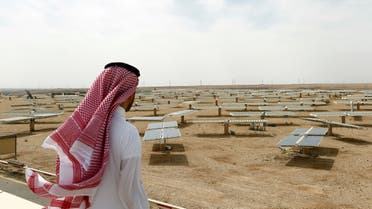Vanessa Ghanem, Al Arabiya English. 18 September ,2024

Saudi Arabia seeks to position itself as a player in the global renewable energy sector with an ambitious goal of sourcing 50 percent of its electricity from renewables by 2030. This commitment includes a substantial investment in solar energy, leveraging the country’s abundant sunlight.
By the end of the decade, Saudi Arabia plans to generate 58.7 gigawatts (GW) of renewable energy, including 40 GW from solar photovoltaics (PV), 16 GW from wind energy and 2.7 GW from concentrated solar power.
The Kingdom’s solar manufacturing initiative, a key component of its Vision 2030, aims to diversify its economy and energy sector away from oil dependence.
Saudi Arabia is actively developing its solar power capacity through various projects.
In July, the Kingdom’s Public Investment Fund (PIF) announced partnerships with China’s JinkoSolar and TCL Zhonghuan, leading producers of solar modules and silicon wafers, along with wind turbine manufacturer Envision Energy.
These collaborations will introduce 30GW of solar PV manufacturing capacity – from ingots to modules – to Saudi Arabia, supporting the goal of localizing 75 percent of renewable energy components by 2030, as outlined in the National Renewable Energy Program.
The move not only aligns with Saudi Arabia’s sustainability targets but also responds to global trade dynamics, with major Chinese clean-energy firms expanding their production amid increasing trade barriers in the US and Europe and fierce competition at home.
Saudi Arabia’s solar edge: Purity and cost
Energy experts suggest that Saudi Arabia is transitioning toward a post-oil era by investing in the solar PV industry. The Kingdom’s rich solar resources and access to raw materials for PV panel production enable it to cater to renewable energy needs while gradually reducing its reliance on traditional energy sources.
“Solar PV panels are primarily made from silica sand, and Saudi Arabia possesses some of the highest purity silica globally, with a purity level of 99.7 percent,” Faisal Faeq, energy adviser with previous roles at Saudi Aramco and the OPEC Secretariat, told Al Arabiya English.
“Saudi Arabia already produces a vast amount of silica, holding about 6 percent of global reserves. Notably, the silica required for solar PV will be supplied at no cost, supported by the Kingdom’s extensive supply chains. The high purity of Saudi silica, available in large quantities and requiring minimal processing, offers a strong advantage. However, establishing an industrial base is needed to convert this resource into solar PV products.”
Solar PV manufacturing involves the production and assembly of components used in solar panels, such as wafers, cells, encapsulants, glass, backsheets, junction boxes, connectors and frames. This process includes creating high-purity silicon, forming it into wafers, and assembling these wafers into solar cells and modules. The goal is to convert sunlight into electricity efficiently and sustainably.
Saudi Arabia’s competitive edge in the solar PV market is further emphasized by its cost-effective production capabilities.
“Saudi Arabia’s low production costs, compared to other markets, are crucial for achieving its goal of becoming a leading solar PV manufacturer,” said Yousef M. Alshammari, CEO and head of energy strategy at the London-based global energy research consultancy CMarkits.
Investment opportunities and challenges
Saudi Arabia’s location at the intersection of Europe, Africa and Asia provides a logistical advantage. The proximity to key markets contributes to diversifying the global solar supply chain. As the Kingdom develops its solar manufacturing sector, it offers a cost-effective production base with enhanced export access, making it a compelling destination for international investors.
This diversification may offer new sourcing options beyond traditional hubs such as China and Germany and mitigate supply risks.
China currently dominates the global solar PV market, accounting for over 80 percent of the market share in all stages of production. Similarly, Germany is a significant player in the global solar PV market, particularly in Europe. Despite its less favorable climate for solar energy, Germany ranks among the world’s leading solar power producers and is renowned for its advanced research in the field.
Although challenging, analysts assert that Saudi Arabia’s competition with established solar hubs remains within reach.
“In the medium to long term, Saudi Arabia’s emergence as a major solar panel manufacturer could challenge the market shares of traditional suppliers,” Faeq said. The Kingdom’s strategic geographic location provides an important benefit, facilitating proximity to large renewable energy projects in the region and reducing shipping times. Once the solar PV industry is firmly established, Saudi Arabia’s extensive experience in meeting energy demands could translate into success in the renewable sector as well.”
Despite the optimistic prospects, Saudi Arabia may encounter hurdles in expanding its solar manufacturing sector, with securing adequate demand being the foremost challenge.
“Investors in renewable energy need to be confident that there is a robust market for their products,” Alshammari said . “While there is local demand, the main focus is on exporting solar panels. Therefore, securing international clients and offering incentives to private investors are fundamental. Also, establishing long-term contracts with customers in regions such as Asia, Europe or America is essential for scaling up the industry effectively.”
